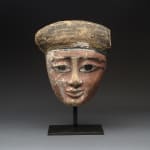Egyptian polychrome wooden mask, 600 BCE - 500 BCE
Wood
25.4 x 22.4 cm
10 x 8 7/8 in
10 x 8 7/8 in
FF.086
In ancient Egypt, masks were primarily used for funerary purposes as death masks. Ancient Egyptians believed that it was extremely important to preserve the body of a dead person because...
In ancient Egypt, masks were primarily used for funerary purposes as death masks.
Ancient Egyptians believed that it was extremely important to preserve the body of a dead person because the soul must have a place where to dwell upon death. Preservation of the dead body was achieved by mummification but it was also considered equally important for the soul to be able to recognize the body, so it can return to it. For such reason death masks were abundantly used, made in the likeness of the deceased.
Early masks were made from wood, followed by masks in cartonnage, a material made from papyrus or linen and soaked in plaster and then molded on a wooden mold, a cheap variant intended for lower class. Royal death masks were made from precious metals, mostly gold or gold leaves on bronze. All death masks were made to resemble the deceased but with slightly enlarged eyes and a faint smile. They also showed the fashion of the moment with painted jewellery and makeup. These death masks later evolved into full-body coffins in the human shape, preserving the same decorations and ornaments. Extracted from the lid of an anthropomorphic coffin and finely sculpted, this perfectly modeled naturalistic and very expressive face was originally framed by a smooth wig, the lappets of which are not preserved. The broad mouth with full lips is pursed into a faint smile with indented corners, the slender nose is well-defined, especially on the outer edges of the nostrils, the eyes are almond-shaped with large, dark irises.
The reddish preserved stucco reveals that the person depicted is a male.
Ancient Egyptians believed that it was extremely important to preserve the body of a dead person because the soul must have a place where to dwell upon death. Preservation of the dead body was achieved by mummification but it was also considered equally important for the soul to be able to recognize the body, so it can return to it. For such reason death masks were abundantly used, made in the likeness of the deceased.
Early masks were made from wood, followed by masks in cartonnage, a material made from papyrus or linen and soaked in plaster and then molded on a wooden mold, a cheap variant intended for lower class. Royal death masks were made from precious metals, mostly gold or gold leaves on bronze. All death masks were made to resemble the deceased but with slightly enlarged eyes and a faint smile. They also showed the fashion of the moment with painted jewellery and makeup. These death masks later evolved into full-body coffins in the human shape, preserving the same decorations and ornaments. Extracted from the lid of an anthropomorphic coffin and finely sculpted, this perfectly modeled naturalistic and very expressive face was originally framed by a smooth wig, the lappets of which are not preserved. The broad mouth with full lips is pursed into a faint smile with indented corners, the slender nose is well-defined, especially on the outer edges of the nostrils, the eyes are almond-shaped with large, dark irises.
The reddish preserved stucco reveals that the person depicted is a male.



